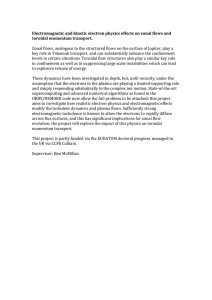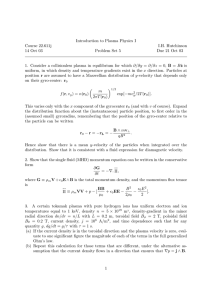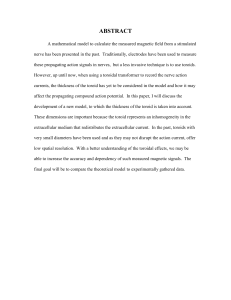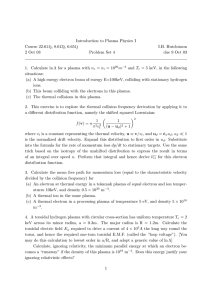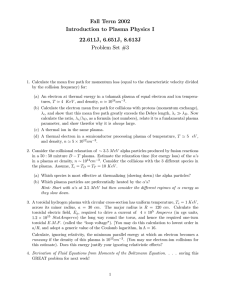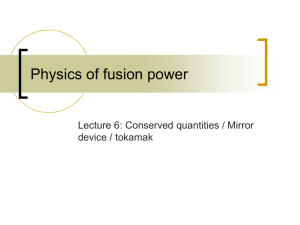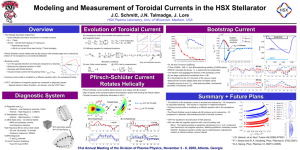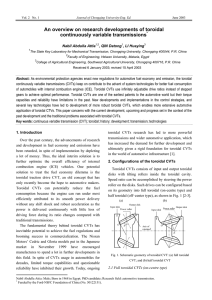Control of plasma parameters by the externally applied toroidal field
advertisement
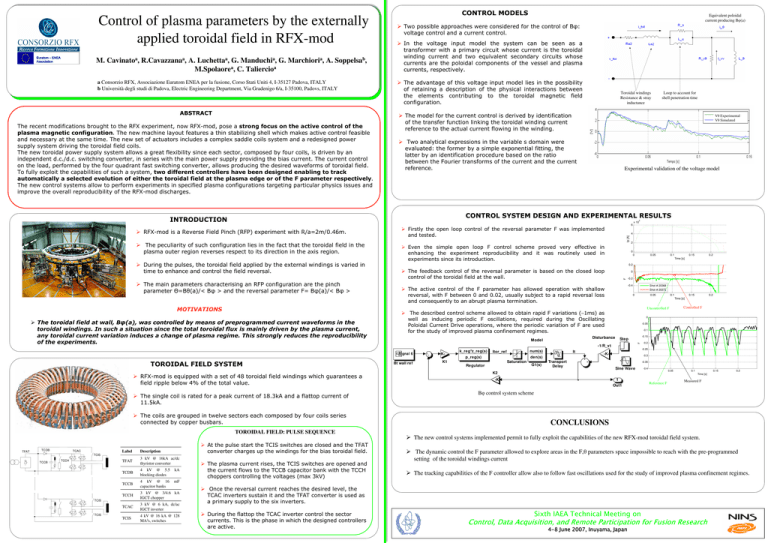
Control of plasma parameters by the externally applied toroidal field in RFX-mod Euratom – ENEA Association M. Cavinatoa, R.Cavazzanaa, A. Luchettaa, G. Manduchia, G. Marchioria, A. Soppelsab, M.Spolaorea, C. Taliercioa a Consorzio RFX, Associazione Euratom ENEA per la fusione, Corso Stati Uniti 4, I-35127 Padova, ITALY b Università degli studi di Padova, Electric Engineering Department, Via Gradenigo 6/a, I-35100, Padovs, ITALY ABSTRACT The recent modifications brought to the RFX experiment, now RFX-mod, pose a strong focus on the active control of the plasma magnetic configuration. The new machine layout features a thin stabilizing shell which makes active control feasible and necessary at the same time. The new set of actuators includes a complex saddle coils system and a redesigned power supply system driving the toroidal field coils. The new toroidal power supply system allows a great flexibility since each sector, composed by four coils, is driven by an independent d.c./d.c. switching converter, in series with the main power supply providing the bias current. The current control on the load, performed by the four quadrant fast switching converter, allows producing the desired waveforms of toroidal field. To fully exploit the capabilities of such a system, two different controllers have been designed enabling to track automatically a selected evolution of either the toroidal field at the plasma edge or of the F parameter respectively. The new control systems allow to perform experiments in specified plasma configurations targeting particular physics issues and improve the overall reproducibility of the RFX-mod discharges. CONTROL MODELS Equivalent poloidal current producing Bφ(a) Two possible approaches were considered for the control of Bφ: voltage control and a current control. In the voltage input model the system can be seen as a transformer with a primary circuit whose current is the toroidal winding current and two equivalent secondary circuits whose currents are the poloidal components of the vessel and plasma currents, respectively. The advantage of this voltage input model lies in the possibility of retaining a description of the physical interactions between the elements contributing to the toroidal magnetic field configuration. Toroidal windings Resistance & stray inductance Loop to account for shell penetration time The model for the current control is derived by identification of the transfer function linking the toroidal winding current reference to the actual current flowing in the winding. Vθ Experimental Vθ Simulated Two analytical expressions in the variable s domain were evaluated: the former by a simple exponential fitting, the latter by an identification procedure based on the ratio between the Fourier transforms of the current and the current reference. Experimental validation of the voltage model CONTROL SYSTEM DESIGN AND EXPERIMENTAL RESULTS INTRODUCTION 5 6 The peculiarity of such configuration lies in the fact that the toroidal field in the plasma outer region reverses respect to its direction in the axis region. During the pulses, the toroidal field applied by the external windings is varied in time to enhance and control the field reversal. The main parameters characterising an RFP configuration are the pinch parameter Θ=Bθ(a)/< Bφ > and the reversal parameter F= Bφ(a)/< Bφ > Firstly the open loop control of the reversal parameter F was implemented and tested. Ip [A] 4 Even the simple open loop F control scheme proved very effective in enhancing the experiment reproducibility and it was routinely used in experiments since its introduction. 2 0 0 0.05 0.1 The feedback control of the reversal parameter is based on the closed loop control of the toroidal field at the wall. RFX-mod is equipped with a set of 48 toroidal field windings which guarantees a field ripple below 4% of the total value. The single coil is rated for a peak current of 18.3kA and a flattop current of 11.5kA. The coils are grouped in twelve sectors each composed by four coils series connected by copper busbars. 0.2 -0.2 -0.4 The active control of the F parameter has allowed operation with shallow reversal, with F between 0 and 0.02, usually subject to a rapid reversal loss and consequently to an abrupt plasma termination. Shot # 20368 Shot # 20372 0 0.05 0.1 Time [s] The described control scheme allowed to obtain rapid F variations (∼1ms) as well as inducing periodic F oscillations, required during the Oscillating Poloidal Current Drive operations, where the periodic variation of F are used for the study of improved plasma confinement regimes. -0.05 -0.1 -0.15 Step -1/R_vt Bt wall ref -K- k_reg*z_reg(s) num(s) Itor_ref p_reg(s) It den(s) K1 Saturation Regulator G1(s) Controlled F 0 Disturbance Model Signal 6 TOROIDAL FIELD SYSTEM 0.15 0 F The toroidal field at wall, Bφ(a), was controlled by means of preprogrammed current waveforms in the toroidal windings. In such a situation since the total toroidal flux is mainly driven by the plasma current, any toroidal current variation induces a change of plasma regime. This strongly reduces the reproducibility of the experiments. 0.2 0.2 Uncontrolled F MOTIVATIONS 0.15 Time [s] F RFX-mod is a Reverse Field Pinch (RFP) experiment with R/a=2m/0.46m. x 10 -0.2 -0.25 -K- Transport Delay -0.3 -0.35 Sine Wave -0.4 0.05 K2 0.1 0.15 0.2 Time [s] -K- 1 Out1 Reference F Measured F Bφ control system scheme CONCLUSIONS TOROIDAL FIELD: PULSE SEQUENCE The new control systems implemented permit to fully exploit the capabilities of the new RFX-mod toroidal field system. TFAT TC DB TCAC At the pulse start the TCIS switches are closed and the TFAT converter charges up the windings for the bias toroidal field. Label Description TFAT 3 kV @ 16kA ac/dc thyristor converter TCDB 4 kV @ 5.5 blocking diodes kA TCCB 4 kV @ 16 capacitor banks mF TCIS TCCB TCCH TCCH 3 kV @ 3/4.6 kA IGCT chopper TCAC 3 kV @ 6 kA, dc/ac IGCT inverter TCIS 4 kV @ 16 kA @ 128 MA2s, switches TCIS TCIS The plasma current rises, the TCIS switches are opened and the current flows to the TCCB capacitor bank with the TCCH choppers controlling the voltages (max 3kV) The dynamic control the F parameter allowed to explore areas in the F,θ parameters space impossible to reach with the pre-programmed setting of the toroidal windings current The tracking capabilities of the F controller allow also to follow fast oscillations used for the study of improved plasma confinement regimes. Once the reversal current reaches the desired level, the TCAC inverters sustain it and the TFAT converter is used as a primary supply to the six inverters. During the flattop the TCAC inverter control the sector currents. This is the phase in which the designed controllers are active. Sixth IAEA Technical Meeting on Control, Data Acquisition, and Remote Participation for Fusion Research Research 4-8 June 2007, Inuyama, Inuyama, Japan
